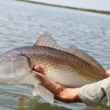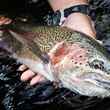Sometimes, a new fly rod feels a little foreign when you break it out of the tube for the first time. Maybe the grip is just a bit different than the rod you’re accustomed to. Maybe the weight is off just a hair. It takes a while for a new stick to really become an extension of your body… a comfortable tool that invites confidence on the water.
That’s just not the case with the new Orvis Recon. I loved the rod from the minute I made the first test cast under the sweeping branches of Lanin National Park’s aracauria trees, and I gravitated to the 9-foot, 5-weight rod for the better part of the two weeks we spent throwing big bugs at Patagonia’s wild trout in April.
What works
It’s a little bit of a cop-out to say that the rod just felt right. But it did. It was light, yet sturdy. Fast, yet able to drop a dry fly on target when accuracy was vital. It has a backbone that I appreciated as we stripped streamers through the clear waters of the upper Malleo. And, when the time came, it put a beetle over a finning 21-inch brown in crystal clear water, and as the river beneath the fly disappeared into a massive swirl, it helped me set the hook and eventually land the big trout that, moments before, had been resting quietly under the autumn Patagonian skies.
The Recon was that extension. It did feel right. And it felt right without the usual “getting to know one another” phase. I’ve fished hundreds of rods over the years, and only a few have really impressed me from the start. The Recon is one of those few.
Weight
What really convinced me that I wasn’t just falling for another of Orvis’ high-end, pricey Manchester-made rods was when, after lunch and on another stretch of the Malleo, I grabbed a different 5-weight. The rod—the product of another respected American rod-maker—felt heavy and clunky. And as our guides tied on big foam dries trailed by heavy nymphs, I felt like I was casting a shot put. The new rod just didn’t feel right. It felt like it weighed a ton compared to the light Recon.

There’s a reason for that. The Recon weighs 2 ⅝ oz.— a graphite pittance compared to many 9-foot 5-weights, and, yet, it was powerful enough to throw long lines, strike back on big fish and handle fights in fast water. That weight-to-power ratio simply instilled confidence.
Now, for clarity, most of my trout fishing is done on smaller, backcountry waters with more supple, slower rods—I’ve become a fan of fiberglass. But I spend a good amount of time chasing trout on the Henry’s Fork and the South Fork, and I’ve settled into a fairly predictable quiver of traditional graphite rods for these storied rivers. I have a faster rod for streamers and big dries; a medium-action 5-weight I use when the PMDs are on the water; and when I’m nymphing under indicators or under big, foam dries, I go with a fast 6-weight with which I’ve become very comfortable.
I think what I liked most about the Recon, as I fumbled my way through an afternoon on the Malleo with a rod that just didn’t agree with me, was that I could envision hitting the South Fork and using only the Recon—and a 5-weight at that—for just about every presentation I could imagine.
Build quality
There’s no doubt the Recon is a handsome rod—-the olive blank built with Orvis’ new ferrule design is nice to look at, as is the black nickel uplocking reel seat complete with a dark burl wood insert. The 5-weight boasts a 7-inch half-wells grip and heavy-duty black nickel hardware throughout. Oddly, the rod could be even lighter if Orvis replaced the traditional snake guides with single-foot guides, but that might compromise some dependability—something that I’m sure came to the minds of designers, given that the rod is backed by Orvis’ standard 25-year warranty.
Action
Over the course of two weeks in Patagonia, I fished the Recon more than any other rod we had on hand, and I think that’s largely because I like the way it handled in varied situations. I was confident that the rod’s fast action could handle the long leaders, the big bugs and the heavy droppers our guides insisted were necessary on these big Argentine rivers.

That said, there were instances where the Recon was simply too fast. In some tight quarters, where a truly delicate touch was needed, I found that I couldn’t slow the rod down enough to put a fly quietly under an overhanging willow or set it down silently in soft water. I don’t know that I’d call the super-fast action a design flaw, but rather a nod to the fact that most avid fly fishers have varied needs, and as well as the Recon handles most situations, it’s not dead-on perfect.
Versatility
As I’ve stated above, this may be the Recon’s best trait. It’s fact action, it’s powerful backbone and it’s light weight, simply make it a great all-around fly rod. Now, while I likely wouldn’t recommend the 5-weight for situations that require true stealth, I’d give this rod consideration in just about every other circumstance. I’d even consider the 5-weight Recon—because of its power—for small saltwater fish. It would be an ideal rod for schoolie speckled trout, ladyfish and inshore Spanish mackerel. That’s a reach, of course—the Recon is a trout rod at its heart. But it does speak to the many situations this rod ably addresses.
What doesn’t work
Simply put, not much. If you’ve read this far, you know I was enamored by the Recon. But, while it’s an excellent all-around rod, I’d probably choose another implement if I was going to spend a day casting tiny dries over Silver Creek’s spooky trout. For me, it’s a rod built for big water and wind, not for quiet slicks that roll over suspicious trout, or even for smaller water where delicacy is as vital as accuracy. I haven’t fished the lighter models (the Recon comes in 3- and 4-weight models, too), and frankly, I likely won’t—I’m biased when it comes to small-stream rods, and fast sticks just don’t meet my needs on streams I can hop across.
Final word
I hated to see the Recon tucked back into the tube on the last day, wondering when I’d get a chance to fish it again. Even a smitten angler is likely to deliberate over a $425 rod, though that’s in the middle of today’s fly rod market. I’m not saying the Recon isn’t worth the expense, it is, especially considering its quality.
As Ferris Bueller once famously said, “It is so choice. If you have the means, I highly recommend picking one up.”
It was good advice all those years ago, and it’s good advice now. The Recon is an excellent all-round rod that can address a variety of situations—we put it through it’s paces, and it performed well. It cut through wind and rain. It handled big flies on the mighty Limay and it handled big fish in big water. It helped us catch countless fish, from 22-inch Patagonian browns in slow water to tail-walking rainbows in swift riffles on the Collon Cura.
The Recon is an excellent fly rod, and likely a great choice for anglers who demand flexibility and want to be able to count on a single rod for an outing that might require presenting dry flies to rising fish, swinging streamers through deep pools or even nymphing under an indicator.
Take Ferris’ word for it.

































Comments
Andy Warywoda replied on Permalink
May be a stretch but how would this rod compare to the Grey's GS rod?
Thanks
Bryan replied on Permalink
I agree, I have the same rod and now all my other rods collect dust... truly "choice"
Pages